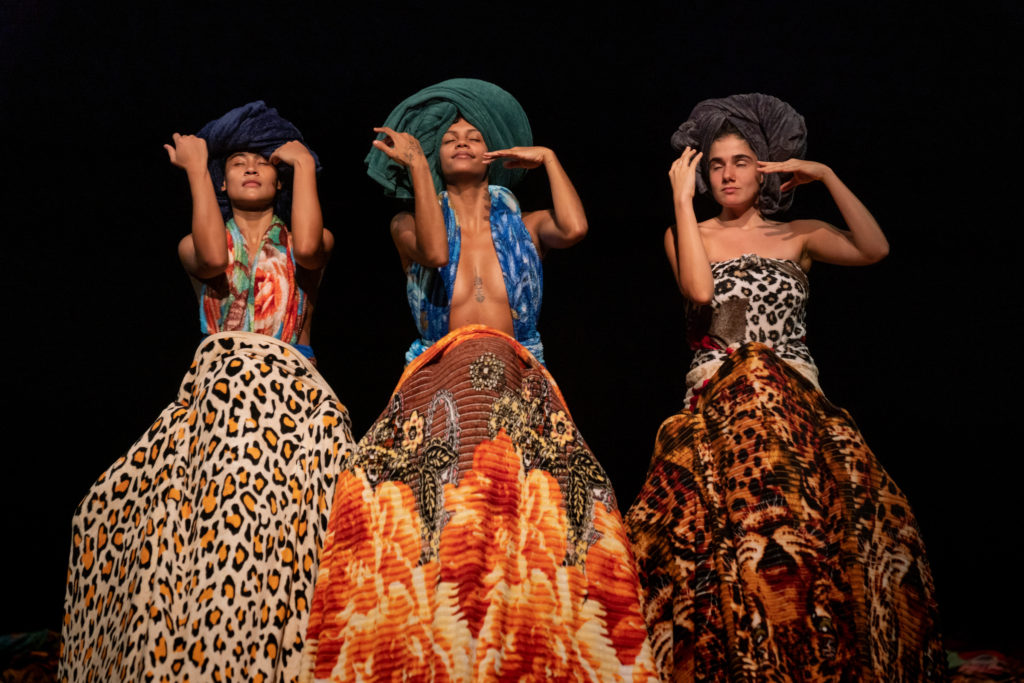Lia Rodrigues’ Encantado: Enchanted, vital beings - Vancouver Ballet Society
- Home
- Reviews 2020 - 2023
- Lia Rodrigues’ Encantado: Enchanted, vital beings

By Philip Szporer
At its core, Encantado (2021), a 75-minute work by Brazilian choreographer and activist Lia Rodrigues, feels like an exuberant, vital response to the coronavirus. Whatever conceptual ideas may be stitched into the piece, at the June 6 performance as part of Montreal’s Festival TransAmériques, what spoke loudly was the sense of collectivity. Through the vibrant differing bodies that inhabited her pulsing stage, transformation and freedom became almost tangible. Encantado means enchanted, but according to the program note, the title also refers to the encantados, animated or magical beings from Afro-Indigenous culture that have the ability to transform rocks, forests, and rivers into sacred places.

Rodrigues, featured at the Festival TransAmériques on several occasions, is a leading figure in Brazilian dance who works in the favelas of Rio de Janeiro. She values the richness of these densely populated shantytowns on the periphery of the city, in spite of the widely known conflicts and complex realities that, she admitted in a public talk, had to be constantly negotiated. While it would be easy to cite the issues facing the favelas –– crowding, unsanitary conditions, poor nutrition, disease, and pollution –– she also embraces the possibility within these communities, where dance and song weave into the fabric of the micro-society and where creative strategies can manifest.
Born in Saõ Paulo, Rodrigues has worked in dance for nearly 40 years. Trained in classical ballet, she danced for French choreographer Maguy Marin in the early 1980s, and upon returning to Brazil in 1990, founded the Lia Rodrigues Companhia de Danças in Rio. More recently, she’s run a dance school in Rio’s Maré favela, in partnership with a local NGO.

On the Encantado stage, out of the total darkness, in silence, a carpet woven from different fabrics in bright bold colours and patterns is slowly rolled out across the vast Usine C stage by some of the performers. The scene reminded me of Dolly Parton’s touching song, Coat of Many Colours, where she sings, “I recall a box of rags that someone gave us/ And how my momma put the rags to use…” The dancers leave and, as the lights rise, return one by one, naked, simply walking. They reach for a piece of fabric, crawling underneath. The cloths become turbans, wraps, and gowns. It threw me back to childhood, when it was so easy to spin in place or run with an old sheet in your hands, the air ballooning the cloth.
The textiles are expressions of whimsy and play, and as deftly handled by her cast of eleven, there is an overriding sense of delight in their use. The piles of material evoke abundance, but the set-up also suggests that fabric like this is quite practical, often worn by the homeless staving off the night’s cold.

For a good portion of the show, the performers turn the stage into a carnival of sorts, with the dancers preening on an imaginary runway, or making faces, tongues darting out, eyes bulging, wrapped in their own worlds or imaginations. At other times, they band together, creating unison jigs accompanied by the occasional howl from one of the dancers. While cloth drapes on their bodies, bare skin is ever-present, and occasionally private parts pop out quite naturally. In the face of what the media often characterizes as despair within the favelas, this dance seems healing and joyous.
The pulsing music, a recording performed on European-influenced maracas and Indigenous traditional instruments, is composed of excerpts of songs of the Guaraní, the most numerous of Brazil’s Indigenous peoples, whose lands are continuously threatened by ranchers. Rodrigues heard these songs played during a protest to acknowledge their endangered ancestral territories. The music, and the underlying struggle, is another reflection of the plural space of Brazilian society that she invites audiences to experience.

